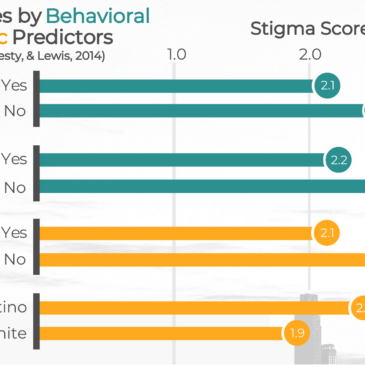People with substance use problems are widely stigmatized, a harmful societal notion reinforced by media depictions of drug use, misguided public policy, and punishments by criminal justice systems. Drug-related stigma is highly present for people who inject drugs (PWID), likely due in part to its association with HIV. On top of this, PWID often feel ashamed of their habits. This “self-stigma” encourages PWID to hide their addiction, avoiding crucial treatment and social support. This week, as part of our Special Series on Stigma and Addiction, we review a study by Alexis Rivera and colleagues that investigated which injection risk behaviors and demographic factors are associated with self-stigma among PWID in New York City.
What was the research question?
What demographic characteristics and injection behaviors are most related to self-stigma among PWID?
What did the researchers do?
The researchers conducted secondary data analysis using data from a 2013 study of New York City pharmacies that sold non-prescription syringes. In the 2013 study, pharmacy customers completed a survey assessing recent substance injection behaviors including frequency of injection, number of injection partners, use of sterile versus non-sterile syringes, and syringe source (pharmacy, syringe exchange program, or both). The survey also assessed self-stigma felt by participants and demographic information. From this data, Rivera and colleagues selected a subset of 132 customers at three pharmacies located in neighborhoods with high drug use. These participants included in this study all reported injecting drugs within the past three months. The researchers used t-tests and ANOVA to determine predictors of self-stigma in PWID.
What did they find?
Participants who used syringe exchange programs reported significantly lower self-stigma scores on average than those who did not use these programs. Participants who acquired syringes only from pharmacies or syringe exchange programs also reported significantly lower self stigma than those who did not always use these sources. Respondents with a high school education or equivalent had significantly lower self-stigma scores than respondents without one, and White participants reported significantly lower self-stigma scores than Latino participants (see figure).

Figure. Average self-stigma scores among participants based on injection behaviors and demographic characteristics. Click image to enlarge.
Why do these findings matter?
The association of higher self-stigma and less frequent use of pharmacies and syringe exchange programs suggests many PWID don’t feel comfortable disclosing their issues. While working to counter stigma is important, developing private or more inviting spaces for sterile syringe access is another solution. Demographic predictors should be considered as well: higher self-stigma in Latino (compared to White) participants could be due to differences in drug-related discrimination, and those with less education may have less knowledge of mental illness and consequently be less accepting of their friends and family members who inject drugs, or even themselves. Both of these vulnerable populations can be targets for intervention.
Every study has limitations. What are the limitations in this study?
Snowball sampling of pharmacy syringe customers decreases external validity, because these people use drugs more safely than PWID who do not buy syringes from pharmacies. Self-stigma scores from this sample could be lower than scores from a wider PWID population. Also, this study utilized a cross-sectional design, so we can’t conclude on the basis of these findings whether stigma influences syringe source or vice versa (or if a third variable influences both stigma and syringe source). Assessing these variables over time could help shed light on what causes what.
For more information:
The CDC has a list of resources for people living with HIV/AIDS. Our Addiction Resources page has free, anonymous resources for people concerned about substance use or other expressions of addiction. The National Helpline is a free treatment and information services available 24/7. Our Addiction Resources page has free, anonymous resources for people concerned about substance use or other expressions of addiction.
— Jamie Juviler
What do you think? Please use the comment link below to provide feedback on this article.




